sensor MERCEDES-BENZ GLC 2018 Owners Manual
[x] Cancel search | Manufacturer: MERCEDES-BENZ, Model Year: 2018, Model line: GLC, Model: MERCEDES-BENZ GLC 2018Pages: 390, PDF Size: 9.04 MB
Page 9 of 390
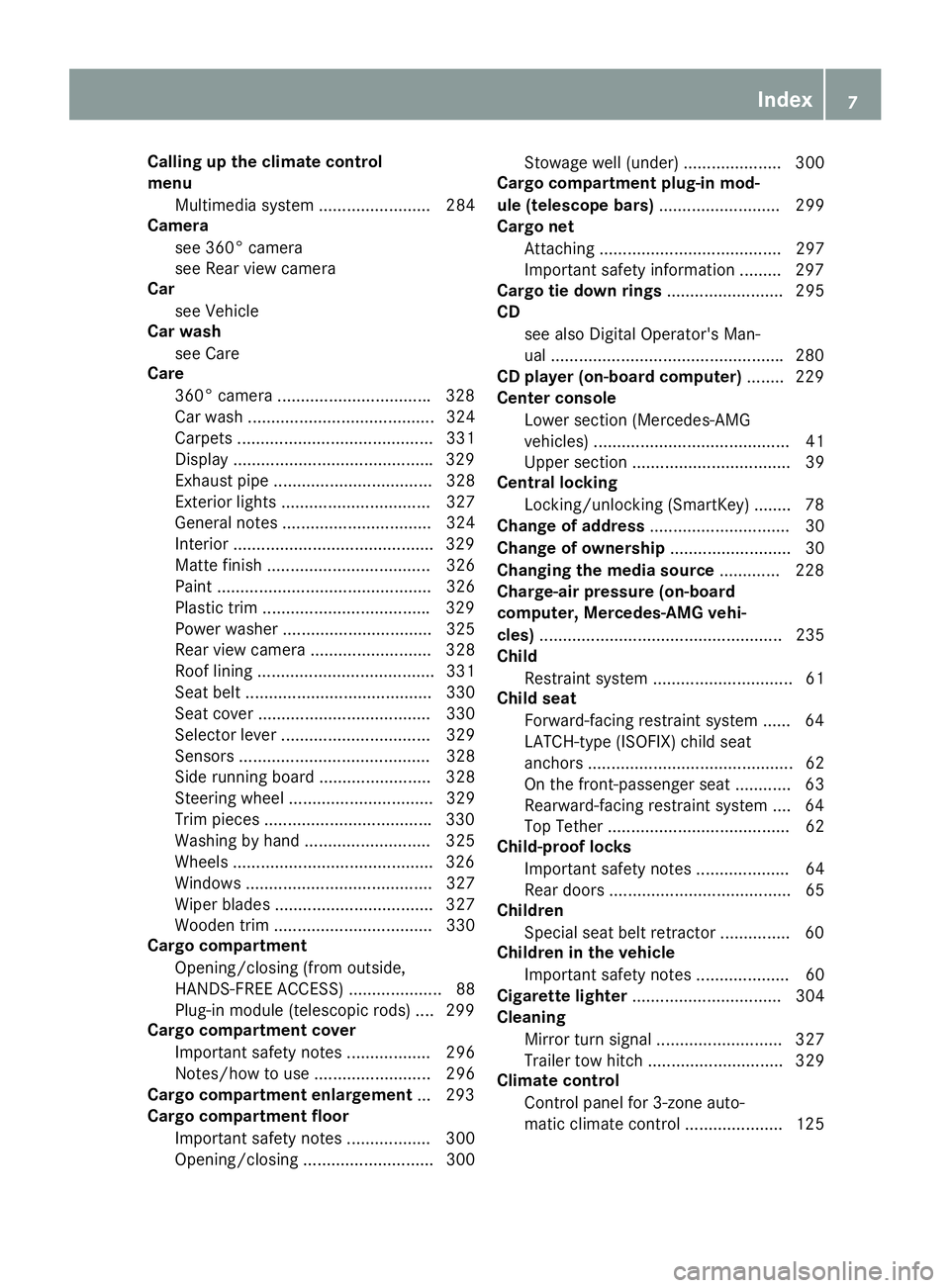
Calling up the climate control
menu
Multimedia system ........................ 284
Camera
see 360° camera
see Rear view camera
Car
see Vehicle
Car wash
see Care
Care
360° camera ................................ .3 28
Car wash ........................................ 324
Carpets .......................................... 331
Display .......................................... .3 29
Exhaust pipe .................................. 328
Exterior lights ................................ 327
General notes ................................ 324
Interior .......................................... .3 29
Matte finish ................................... 326
Paint .............................................. 326
Plastic trim ................................... .3 29
Power washer ................................ 325
Rear view camera .......................... 328
Roof lining ...................................... 331
Seat belt ........................................ 330
Seat cover ..................................... 330
Selector lever ................................ 329
Sensors ......................................... 328
Side running board ........................ 328
Steering wheel ............................... 329
Trim pieces ................................... .3 30
Washing by hand ........................... 325
Wheels .......................................... .3 26
Windows ........................................ 327
Wiper blades .................................. 327
Wooden trim .................................. 330
Cargo compartment
Opening/closing (from outside,
HANDS-FREE ACCESS) .................... 88
Plug-in module (telescopic rods) .... 299
Cargo compartment cover
Important safety notes .................. 296
Notes/how to use ......................... 296
Cargo compartment enlargement ... 293
Cargo compartment floor
Important safety notes .................. 300
Opening/closing ............................ 300 Stowage well (under) ..................... 300
C argo compartment plug-in mod-
ule (telescope bars) .......................... 299
Cargo net
Attaching ....................................... 297
Important safety information ......... 297
Cargo tie down rings ......................... 295
CD
see also Digital Operator's Man-
ual ................................................. .2 80
CD player (on-board computer) ....... .2 29
Center console
Lower section (Mercedes-AMG
vehicles) .......................................... 41
Upper section .................................. 39
Central locking
Locking/unlocking (SmartKey) ....... .7 8
Change of address .............................. 30
Change of ownership .......................... 30
Changing the media source ............ .2 28
Charge-air pressure (on-board
computer, Mercedes-AMG vehi-
cles) .................................................... 235
Child
Restraint system .............................. 61
Child seat
Forward-facing restraint system ...... 64
LATCH-type (ISOFIX) child seat
anchors ............................................ 62
On the front-passenger seat ............ 63
Rearward-facing restraint system .... 64
Top Tether ....................................... 62
Child-proof locks
Important safety notes .................... 64
Rear doors ....................................... 65
Children
Special seat belt retractor ............... 60
Children in the vehicle
Important safety notes .................... 60
Cigarette lighter ................................ 304
Cleaning
Mirror turn signal ........................... 327
Trailer tow hitch ............................. 329
Climate control
Control panel for 3-zone auto-
matic climate control ..................... 125 Index 7
Page 19 of 390
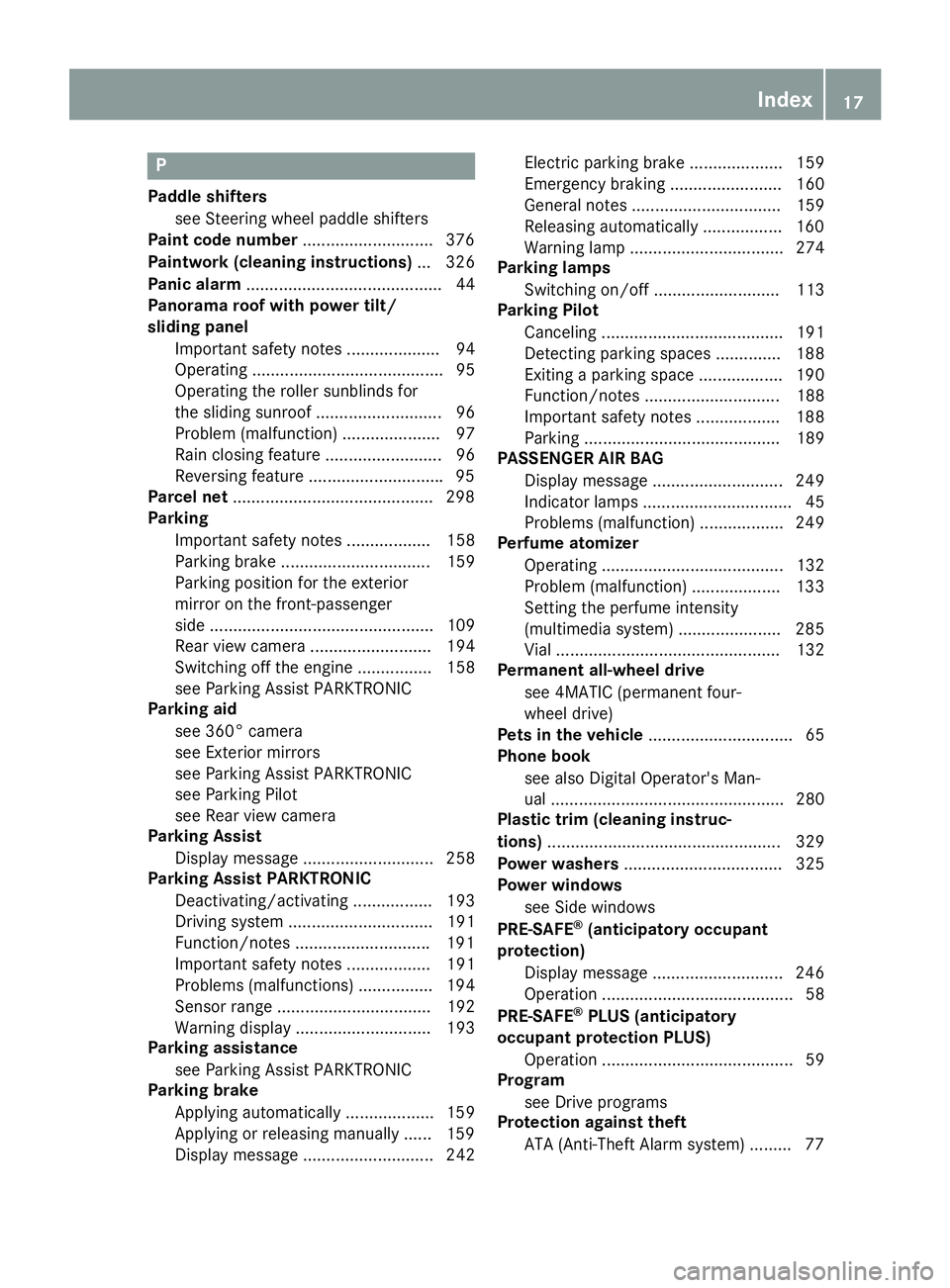
P Paddle shifters
see Steering wheel paddle shifters
Paint code number ........................... .3 76
Paintwork (cleaning instructions) ... 326
Panic alarm .......................................... 44
Panorama roof with power tilt/
sliding panel
Important safety notes .................... 94
Operating ......................................... 95
Operating the roller sunblinds for
the sliding sunroof ........................... 96
Problem (malfunction) ..................... 97
Rain closing feature ......................... 96
Reversing feature ............................ .9 5
Parcel net .......................................... .2 98
Parking
Important safety notes .................. 158
Parking brake ................................ 159
Parking position for the exterior
mirror on the front-passenger
side ................................................ 109
Rear view camera .......................... 194
Switching off the engine ................ 158
see Parking Assist PARKTRONIC
Parking aid
see 360° camera
see Exterior mirrors
see Parking Assist PARKTRONIC
see Parking Pilot
see Rear view camera
Parking Assist
Display message ............................ 258
Parking Assist PARKTRONIC
Deactivating/activating ................. 193
Driving system ............................... 191
Function/notes ............................ .1 91
Important safety notes .................. 191
Problems (malfunctions) ................ 194
Sensor range ................................. 192
Warning display ............................. 193
Parking assistance
see Parking Assist PARKTRONIC
Parking brake
Applying automatically ................... 159
Applying or releasing manually ...... 159
Display message ............................ 242 Electric parking brake .................... 159
Emergency braking ........................ 160
General notes ................................ 159
Releasing automatically ................. 160
Warning lamp ................................. 274
Parking lamps
Switching on/off ........................... 113
Parki ng Pi lot
C anceling ....................................... 191
Detecting parking spaces .............. 188
Exiting a parking space .................. 190
Function/notes ............................. 188
Important safety notes .................. 188
Parking .......................................... 189
PASSENGER AIR BAG
Display message ............................ 249
Indicator lamps ................................ 45
Problems (malfunction) .................. 249
Perfume atomizer
Operating ....................................... 132
Problem (malfunction) ................... 133
Setting the perfume intensity
(multimedia system) ...................... 285
Vial ................................................ 132
Permanent all-wheel drive
see 4MATIC (permanent four-
wheel drive)
Pets in the vehicle ............................... 65
Phone book
see also Digital Operator's Man-
ual .................................................. 280
Plastic trim (cleaning instruc-
tions) .................................................. 329
Power washers .................................. 325
Power windows
see Side windows
PRE-SAFE ®
(anticipatory occupant
protection)
Display message ............................ 246
Operation ......................................... 58
PRE-SAFE ®
PLUS (anticipatory
occupant protection PLUS)
Operation ......................................... 59
Program
see Drive programs
Protection against theft
ATA (Anti-Theft Alarm system) ......... 77 Index 17
Page 20 of 390

Immobilizer ...................................... 76
Protection of the environment
General notes .................................. 28
Pulling away
Automatic transmission ................ .1 39
General notes ................................ 139
Hill start assist ............................... 140
Trailer ............................................ 140
QQR code
Mercedes-Benz Guide App ................. 1
Rescue card ..................................... 33
Qualified specialist workshop ........... 32
Quick access for audio and tele-
phone
Changing the station/music
track .............................................. 283
RRACE START (Mercedes-AMG vehi-
cles) .................................................... 183
RACE TIMER (on-board computer,
Mercedes-AMG vehicles) .................. 237
Radar sensor system
Display message ............................ 247
Radiator cover ................................... 319
Radio
Selecting a station ......................... 228
Radio mode
see also Digital Operator's Man-
ual ................................................. .2 80
Radio-wave reception/transmis-
sion in the vehicle
Declaration of conformity ................ 31
Rain closing feature (panorama
roof with power tilt/sliding panel) .... 96
Reading lamp ..................................... 116
Rear compartment
Setting the air vents ..................... .1 34
Setting the airflow ......................... 129
Setting the temperature ................ 128
Rear fog lamp
Display message ............................ 251
Switching on/off ........................... 113 Rear seat
Adjusting the angle of the backr-
ests ................................................ 295
Rear seat (folding the backrest for-
wards/back) ...................................... 293
Rear seat backrest
Display message ............................ 266
Rear seats
Display message ............................ 266
Rear view camera
"Reverse parking" function ............ 196
Cleaning instructions ..................... 328
Coupling up a trailer function ....... .1 98
Display in the multimedia system .. 195
General notes ................................ 194
Object detection (function/
notes) ............................................ 198
Switching on/off ........................... 195
Wide-angle function ....................... 198
Rear window defroster
Problem (malfunction) ................... 131
Switching on/off ........................... 130
Rear window wiper
Replacing the wiper blade .............. 122
Switching on/off ........................... 121
Rear-view mirror
Dipping (automatic) ....................... 108
Recuperation display ........................ 225
Re flec tive safety jacket .................... 332
Refrigerant (air-conditioning sys-
tem)
Important safety notes .................. 381
Refueling
Fuel gauge ....................................... 37
Important safety notes .................. 155
see Fuel
Remote control
Garage door opener ....................... 314
Programming (garage door
opener) .......................................... 315
Replacing bulbs
Backup lamp .................................. 119
High-beam headlamps ................... 118
Important safety notes .................. 116
Installing/removing the cover
(front wheel arch) .......................... 118
Low-beam headlamps .................... 117
Opening/closing side trim panel s. .1 1918
Index
Page 21 of 390
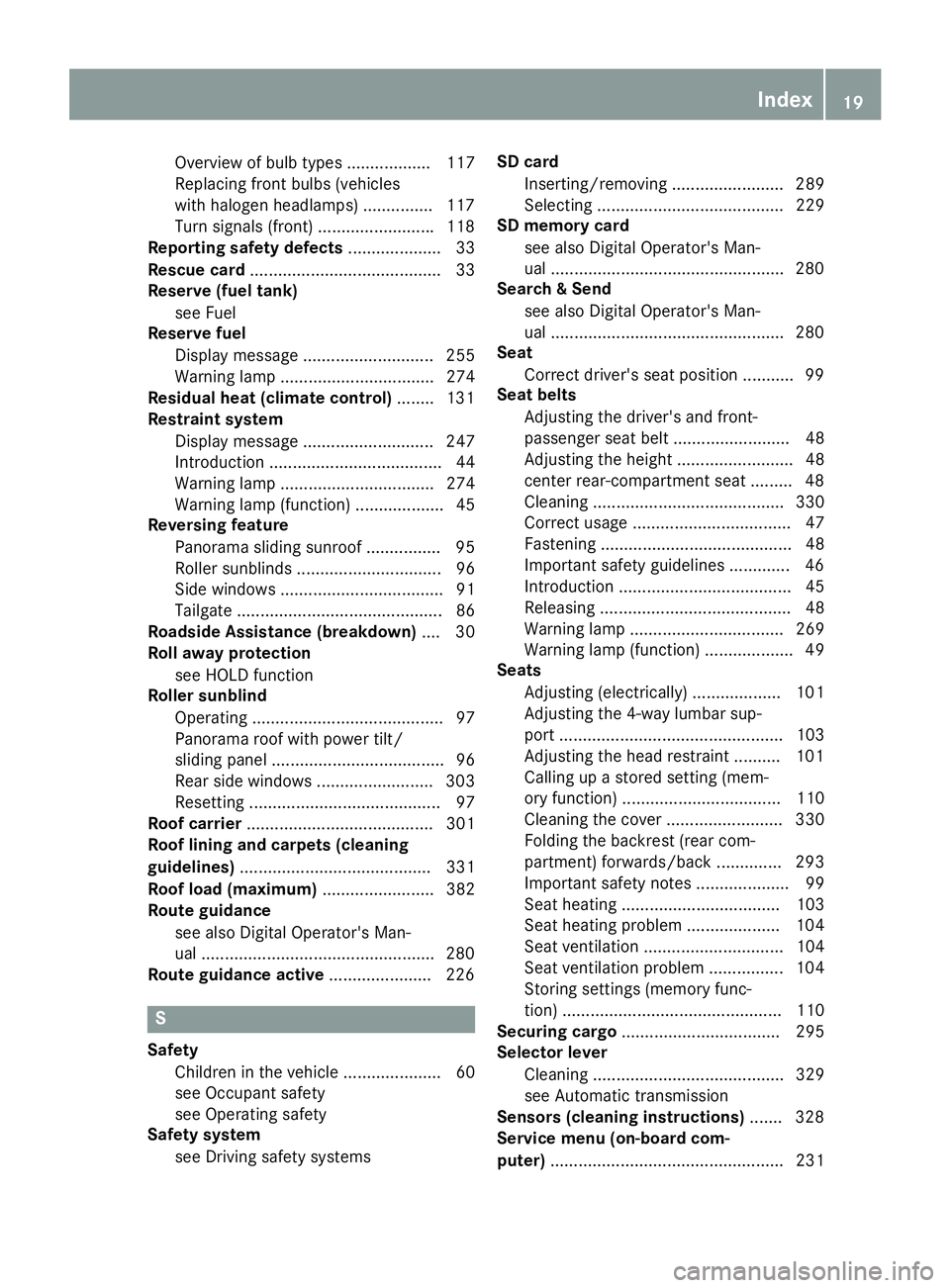
Overview of bulb types .................. 117
Replacing front bulbs (vehicles
with halogen headlamps) ............... 117
Turn signals (front) ........................ .1 18
Reporting safety defects .................... 33
Rescue card ......................................... 33
Reserve (fuel tank)
see Fuel
Reserve fuel
Display message ............................ 255
Warning lamp ................................. 274
Residual heat (climate control) ....... .1 31
Restraint system
Display message ............................ 247
Introduction ..................................... 44
Warning lamp ................................. 274
Warning lamp (function) ................... 45
Reversing feature
Panorama sliding sunroof ................ 95
Roller sunblinds ............................... 96
Side windows ................................... 91
Tailgate ............................................ 86
Roadside Assistance (breakdown) .... 30
Roll away protection
see HOLD function
Roller sunblind
Operating ......................................... 97
Panorama roof with power tilt/
sliding panel ..................................... 96
Rear side windows ......................... 303
Resetting ......................................... 97
Roof carrier ........................................ 301
Roof lining and carpets (cleaning
guidelines) ......................................... 331
Roof load (maximum) ........................ 382
Route guidance
see also Digital Operator's Man-
ual ................................................. .2 80
Route guidance active ..................... .2 26
S
Safety
Children in the vehicle ..................... 60
see Occupant safety
see Operating safety
Safety system
see Driving safety systems SD card
Inserting/removing ........................ 289
Selecting ........................................ 229
SD memory card
see also Digital Operator's Man-
ual ................................................. .2 80
Search & Send
see also Digital Operator's Man-
ual ................................................. .2 80
Seat
Correct driver's seat position ........... 99
Seat belts
Adjusting the driver's and front-
passenger seat belt ......................... 48
Adjusting the height ......................... 48
center rear-compartment seat ......... 48
Cleaning ......................................... 330
Correct usage .................................. 47
Fastening ......................................... 48
Important safety guidelines ............. 46
Introduction ..................................... 45
Releasing ......................................... 48
Warning lamp ................................. 269
Warning lamp (function) ................... 49
Seats
Adjusting (electrically) ................... 101
Adjusting the 4-way lumbar sup-
port ................................................ 103
Adjusting the head restraint .......... 101
Calling up a stored setting (mem-
ory function) .................................. 110
Cleaning the cover ......................... 330
Folding the backrest (rear com-
partment) forwards/back .............. 293
Important safety notes .................... 99
Seat heating .................................. 103
Seat heating problem .................... 104
Seat ventilation .............................. 104
Seat ventilation problem ................ 104
Storing settings (memory func-
tion) ............................................... 110
Securing cargo .................................. 295
Selector lever
Cleaning ......................................... 329
see Automatic transmission
Sensors (cleaning instructions) ....... 328
Service menu (on-board com-
puter) .................................................. 231 Index 19
Page 52 of 390

board, for example. Your feet may otherwise
be in the deployment area of the air bag. R
For this reason, always secure persons less
than 5 ft (1.50 m) tall in suitable restraint sys-
tems. Up to this height, the seat belt cannot
be worn correctly.
If a child is traveling in your vehicle, also
observe the following notes: R
Always secure children under twelve years of
age and less than 5 ft (1.50 m) tall in suitable
child restraint systems. R
Child restraint systems should be installed on
the rear seats. R
Only secure a child in a rearward-facing child
restraint system on the front-passenger seat
when the front-passenger front air bag is
deactivated. If the PASSENGER AIR BAG OFF
indicator lamp is permanently lit, the front-
passenger front air bag is deactivated
( Y
page 45).R
Always observe the instructions and safety
notes on the "Occupant Classification System
(OCS)" ( Y
page 52) and on "Children in the
vehicle" ( Y
page 60) in addition to the child
restraint system manufacturer's installation
and operating instructions.
Objects in the vehicle interior may prevent
an air bag from functioning correctly. Before
starting your journey and to avoid risks resulting
from the speed of the air bag as it deploys, make
sure that: R
there are no people, animals or objects
between th e vehicle occupants and an air bagR
there are no objects between the seat, door
and B-pillar R
there are no hard objects, e.g. coat hangers,
hanging on the grab handles or coat hooks R
no accessories, such as cup holders, are
attached to the vehicle within the deployment
area of an air bag, e.g. to doors, side windows,
rear side trim or side walls R
no heavy, sharp-edged or fragile objects are in
the pockets of your clothing. Store such
objects in a suitable place
G WARNING
If you modify the air bag cover or affix objects
such as stickers to it, the air bag can no longer
function correctly. There is an increased risk
of injury. Never modify an air bag cover or affix objects
to it.
G WARNING
Sensors to control the air bags are located in
the doors. Modifications or work not per-
formed correctly to the doors or door panel-
ing, as well as damaged doors, can lead to the
function of the sensors being impaired. The air
bags might therefore not function properly
anymore. Consequently, the air bags cannot
protect vehicle occupants as they are
designed to do. There is an increased risk of
injury.
Never modify the doors or parts of the doors.
Always have work on the doors or door pan-
eling carried out at a qualified specialist work-
shop.
Front air bags
! Do not place heavy objects on the front-
passenger seat. This could cause the system
to identify the seat as being occupied. In the
event of an accident, the restraint systems on
the front-passenger side may be triggered
and have to be replaced.
Driver's air bag �C deploys in front of the steer-
ing wheel. Front-passenger front air bag �D
deploys in front of and above the glove box.
When deployed, the front air bags offer addi-
tional head and thorax protection for the occu-
pants in the front seats.
The PASSENGER AIR BAG OFF indicator lamp
informs you about the status of the front-
passenger front air bag ( Y
page 45).50
Occupant safety
Safety
Page 53 of 390

The front-passenger front air bag will only
deploy if: R
the system, based on the OCS weight sensor
readings, detects that the front-passenger
seat is occupied ( Y
page 52). The
PASSENGER AIR BAG OFF indicator lamp is
not lit ( Y
page 52)R
the restraint system control unit predicts a
high accident severity
Driver's knee bag
Driver's knee bag �C deploys under the steering
column. The driver's knee bag is deployed
together with the front air bag.
The driver's knee bag offers additional thigh,
knee and lower leg protection for the occupant
in the driver's seat.
Side impact air bags
G WARNING
Unsuitable seat covers can obstruct or pre-
vent deployment of the air bags integrated
into the seats. Consequently, the air bags
cannot protect vehicle occupants as they are
designed to do. In addition, the operation of
the occupant classification system (OCS)
could be adversely affected. This poses an
increased risk of injury or even fatal injury.
You should only use seat covers that have
been approved for the respective seat by
Mercedes-Benz. Front side impact air bags �C and rear side
impact air bags �D deploy next to the outer bol-
ster of the seat backrest.
When deployed, the side impact air bag offers
additional thorax protection. However, it does
not protect the: R
Head R
Neck R
Arms
If the restraint system control unit detects a side
impact, the side impact air bag is deployed on
the side on which the impact occurs.
The side impact air bag on the front-passenger
side deploys under the following conditions: R
the OCS system detects that the front-
passenger seat is occupied or R
the seat belt buckle tongue is engaged in the
belt buckle of the front-passenger seat
If the belt tongue is engaged in the belt buckle,
the side impact air bag on the front-passenger
side deploys if an appropriate accident situation
occurs. In this case, deployment is independent
of whether the front-passenger seat is occupied
or not.
Window curtain air bags Occupant safety 51
Safety Z
Page 60 of 390
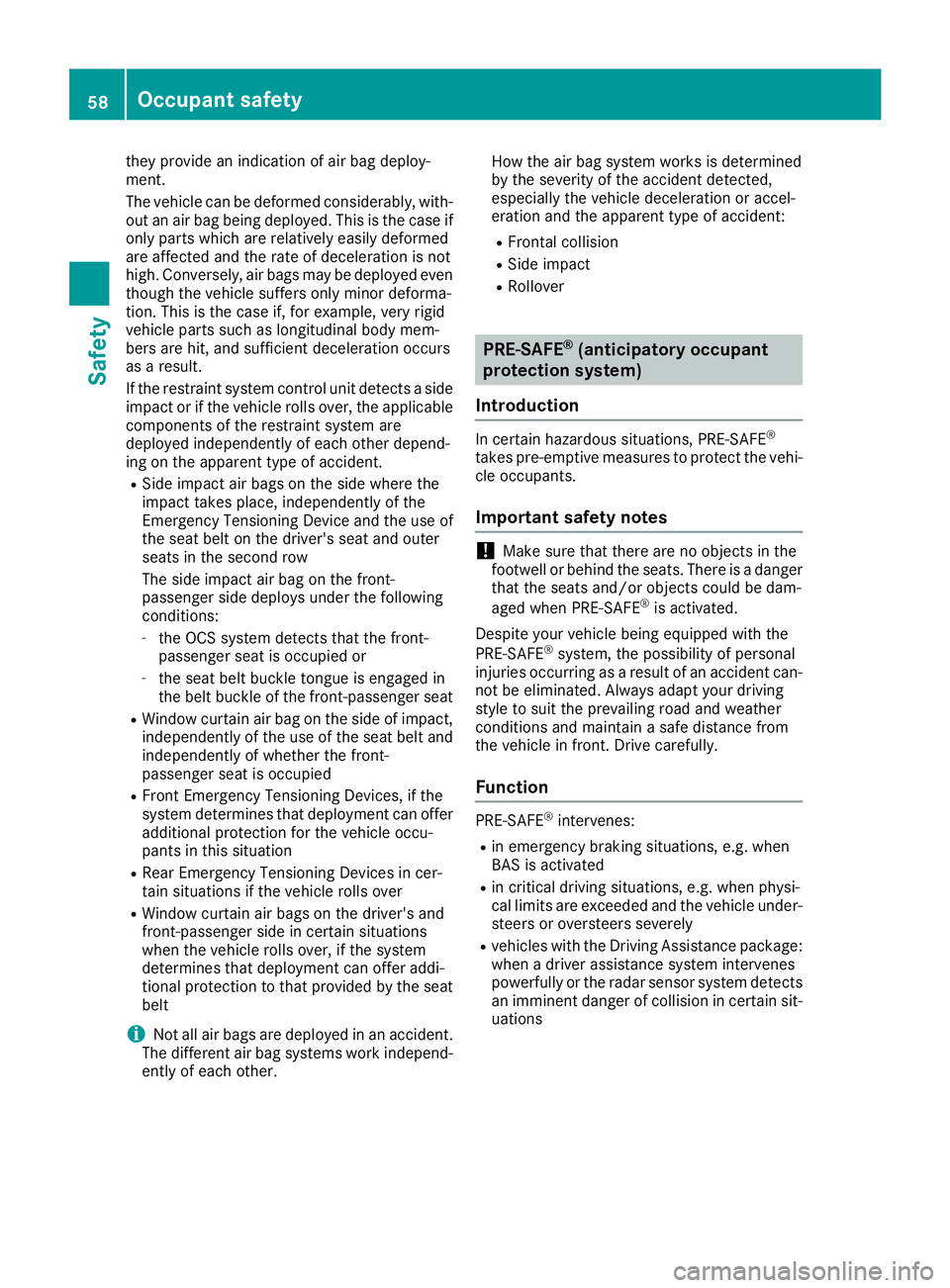
they provide an indication of air bag deploy-
ment.
The vehicle can be deformed considerably, with-
out an air bag being deployed. This is the case if
only parts which are relatively easily deformed
are affected and the rate of deceleration is not
high. Conversely, air bags may be deployed even
though the vehicle suffers only minor deforma-
tion. This is the case if, for example, very rigid
vehicle parts such as longitudinal body mem-
bers are hit, and sufficient deceleration occurs
as a result.
If the restraint system control unit detects a side
impact or if the vehicle rolls over, the applicable
components of the restraint system are
deployed independently of each other depend-
ing on the apparent type of accident. R
Side impact air bags on the side where the
impact takes place, independently of the
Emergency Tensioning Device and the use of
the seat belt on the driver's seat and outer
seats in the second row
The side impact air bag on the front-
passenger side deploys under the following
conditions: -
the OCS system detects that the front-
passenger seat is occupied or -
the seat belt buckle tongue is engaged in
th e belt buckle of the front-passenger seatR
Window curtain air bag on the side of impact,
independently of the use of the seat belt and
independently of whether the front-
passenger seat is occupied R
Front Emergency Tensioning Devices, if the
system determines that deployment can offer
additional protection for the vehicle occu-
pants in this situation R
Rear Emergency Tensioning Devices in cer-
tain situations if the vehicle rolls over R
Window curtain air bags on the driver's and
front-passenger side in certain situations
when the vehicle rolls over, if the system
determines that deployment can offer addi-
tional protection to that provided by the seat
belt
i Not all air bags are deployed in an accident.
The different air bag systems work independ-
ently of each other. How the air bag system works is determined
by the severity of the accident detected,
especially the vehicle deceleration or accel-
eration and the apparent type of accident: R
Frontal collision R
Side impact R
Rollover
PRE-SAFE ®
(anticipatory occupant
protection system)
Introduction In certain hazardous situations, PRE-SAFE ®
takes pre-emptive measures to protect the vehi-
cle occupants.
Important safety notes
! Make sure that there are no objects in the
footwell or behind the seats. There is a danger
that the seats and/or objects could be dam-
aged when PRE-SAFE ®
is activated.
Despite your vehicle being equipped with the
PRE-SAFE ®
system, the possibility of personal
injuries occurring as a result of an accident can-
not be eliminated. Always adapt your driving
style to suit the prevailing road and weather
conditions and maintain a safe distance from
the vehicle in front. Drive carefully.
Function PRE-SAFE ®
intervenes: R
in emergency braking situations, e.g. when
BAS is activated R
in critical driving situations, e.g. when physi-
cal limits are exceeded and the vehicle under-
steers or oversteers severely R
vehicles with the Driving Assistance package:
when a driver assistance system intervenes
powerfully or the radar sensor system detects
an imminent danger of collision in certain sit-
uations58
Occupant safety
Safety
Page 61 of 390
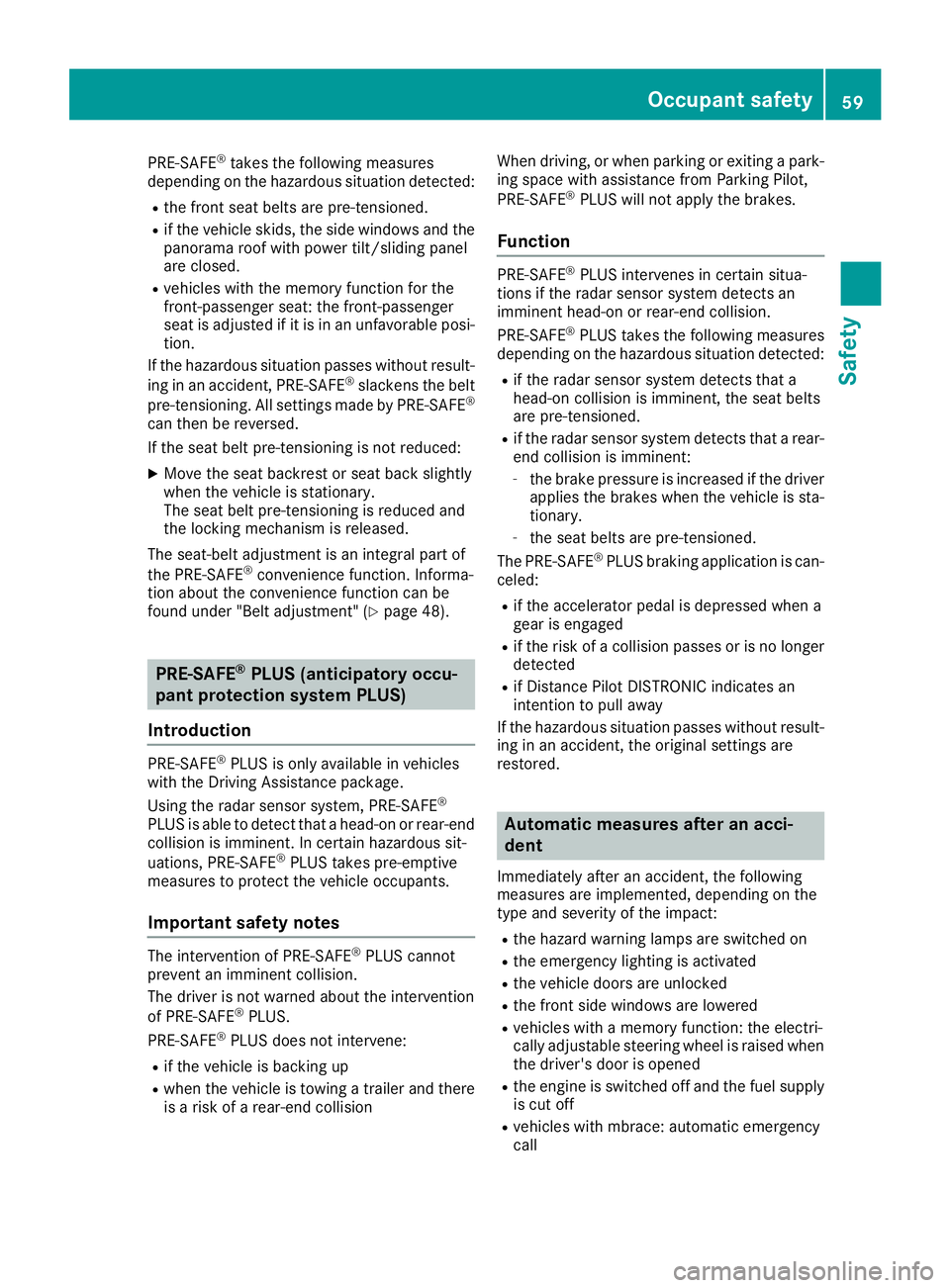
PRE-SAFE ®
takes the following measures
depending on the hazardous situation detected: R
the front seat belts are pre-tensioned. R
if the vehicle skids, the side windows and the
panorama roof with power tilt/sliding panel
are closed. R
vehicles with the memory function for the
front-passenger seat: the front-passenger
seat is adjusted if it is in an unfavorable posi-
tion.
If the hazardous situation passes without result-
ing in an accident, PRE-SAFE ®
slackens the belt
pre-tensioning. All settings made by PRE-SAFE ®
can then be reversed.
If the seat belt pre-tensioning is not reduced: X
Move the seat backrest or seat back slightly
when the vehicle is stationary.
The seat belt pre-tensioning is reduced and
the locking mechanism is released.
The seat-belt adjustment is an integral part of
the PRE-SAFE ®
convenience function. Informa-
tion about the convenience function can be
found under "Belt adjustment" ( Y
page 48).
PRE-SAFE ®
PLUS (anticipatory occu-
pant protection system PLUS)
Introduction PRE-SAFE ®
PLUS is only available in vehicles
with the Driving Assistance package.
Using the radar sensor system, PRE-SAFE ®
PLUS is able to detect that a head-on or rear-end
collision is imminent. In certain hazardous sit-
uations, PRE-SAFE ®
PLUS takes pre-emptive
measures to protect the vehicle occupants.
Important safety notes The intervention of PRE-SAFE ®
PLUS cannot
prevent an imminent collision.
The driver is not warned about the intervention
of PRE-SAFE ®
PLUS.
PRE-SAFE ®
PLUS does not intervene:R
if the vehicle is backing up R
when the vehicle is towing a trailer and there
is a risk of a rear-end collision When driving, or when parking or exiting a park-
ing space with assistance from Parking Pilot,
PRE-SAFE ®
PLUS will not apply the brakes.
Function PRE-SAFE ®
PLUS intervenes in certain situa-
tions if the radar sensor system detects an
imminent head-on or rear-end collision.
PRE-SAFE ®
PLUS takes the following measures
depending on the hazardous situation detected: R
if the radar sensor system detects that a
head-on collision is imminent, the seat belts
are pre-tensioned. R
if the radar sensor system detects that a rear-
end collision is imminent: -
the brake pressure is increased if the driver
applies the brakes when the vehicle is sta-
tionary. -
the seat belts are pre-tensioned.
The PRE-SAFE ®
PLUS braking application is can-
celed: R
if the accelerator pedal is depressed when a
gear is engaged R
if the risk of a collision passes or is no longer
detected R
if Distance Pilot DISTRONIC indicates an
intention to pull away
If the hazardous situation passes without result-
ing in an accident, the original settings are
restored.
Automatic measures after an acci-
dent Immediately after an accident, the following
measures are implemented, depending on the
type and severity of the impact: R
the hazard warning lamps are switched on R
the emergency lighting is activated R
the vehicle doors are unlocked R
the front side windows are lowered R
vehicles with a memory function: the electri-
cally adjustable steering wheel is raised when
the driver's door is opened R
the engine is switched off and the fuel supply
is cut off R
vehicles with mbrace: automatic emergency
callOccupant safety 59
Safety Z
Page 69 of 390
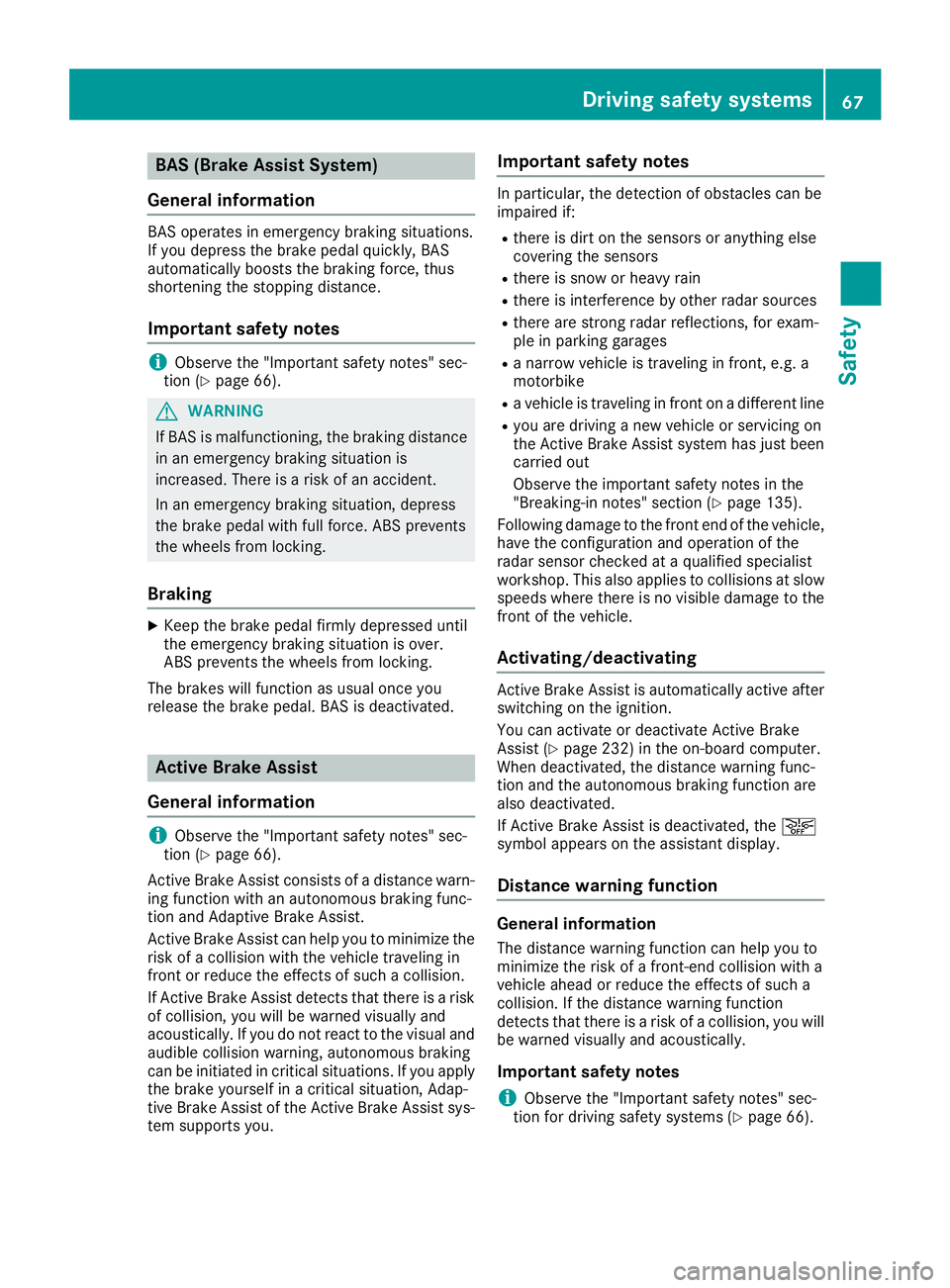
BAS (Brake Assist System)
General information BAS operates in emergency braking situations.
If you depress the brake pedal quickly, BAS
automatically boosts the braking force, thus
shortening the stopping distance.
Important safety notes
i Observe the "Important safety notes" sec-
tion ( Y
page 66).
G WARNING
If BAS is malfunctioning, the braking distance
in an emergency braking situation is
increased. There is a risk of an accident.
In an emergency braking situation, depress
the brake pedal with full force. ABS prevents
the wheels from locking.
Braking X
Keep the brake pedal firmly depressed until
the emergency braking situation is over.
ABS prevents the wheels from locking.
The brakes will function as usual once you
release the brake pedal. BAS is deactivated.
Active Brake Assist
General information
i Observe the "Important safety notes" sec-
tion ( Y
page 66).
Active Brake Assist consists of a distance warn-
ing function with an autonomous braking func-
tion and Adaptive Brake Assist.
Active Brake Assist can help you to minimize the
risk of a collision with the vehicle traveling in
front or reduce the effects of such a collision.
If Active Brake Assist detects that there is a risk
of collision, you will be warned visually and
acoustically. If you do not react to the visual and
audible collision warning, autonomous braking
can be initiated in critical situations. If you apply
the brake yourself in a critical situation, Adap-
tive Brake Assist of the Active Brake Assist sys-
tem supports you. Important safety notes In particular, the detection of obstacles can be
impaired if: R
there is dirt on the sensors or anything else
covering the sensors R
there is snow or heavy rain R
there is interference by other radar sources R
there are strong radar reflections, for exam-
ple in parking garages R
a narrow vehicle is traveling in front, e.g. a
motorbike R
a vehicle is traveling in front on a different line R
you are driving a new vehicle or servicing on
the Active Brake Assist system has just been
carried out
Observe the important safety notes in the
"Breaking-in notes" section ( Y
page 135).
Following damage to the front end of the vehicle,
have the configuration and operation of the
radar sensor checked at a qualified specialist
workshop. This also applies to collisions at slow
speeds where there is no visible damage to the
front of the vehicle.
Activating/deactivating Active Brake Assist is automatically active after
switching on the ignition.
You can activate or deactivate Active Brake
Assist ( Y
page 232) in the on-board computer.
When deactivated, the distance warning func-
tion and the autonomous braking function are
also deactivated.
If Active Brake Assist is deactivated, the �
Page 71 of 390
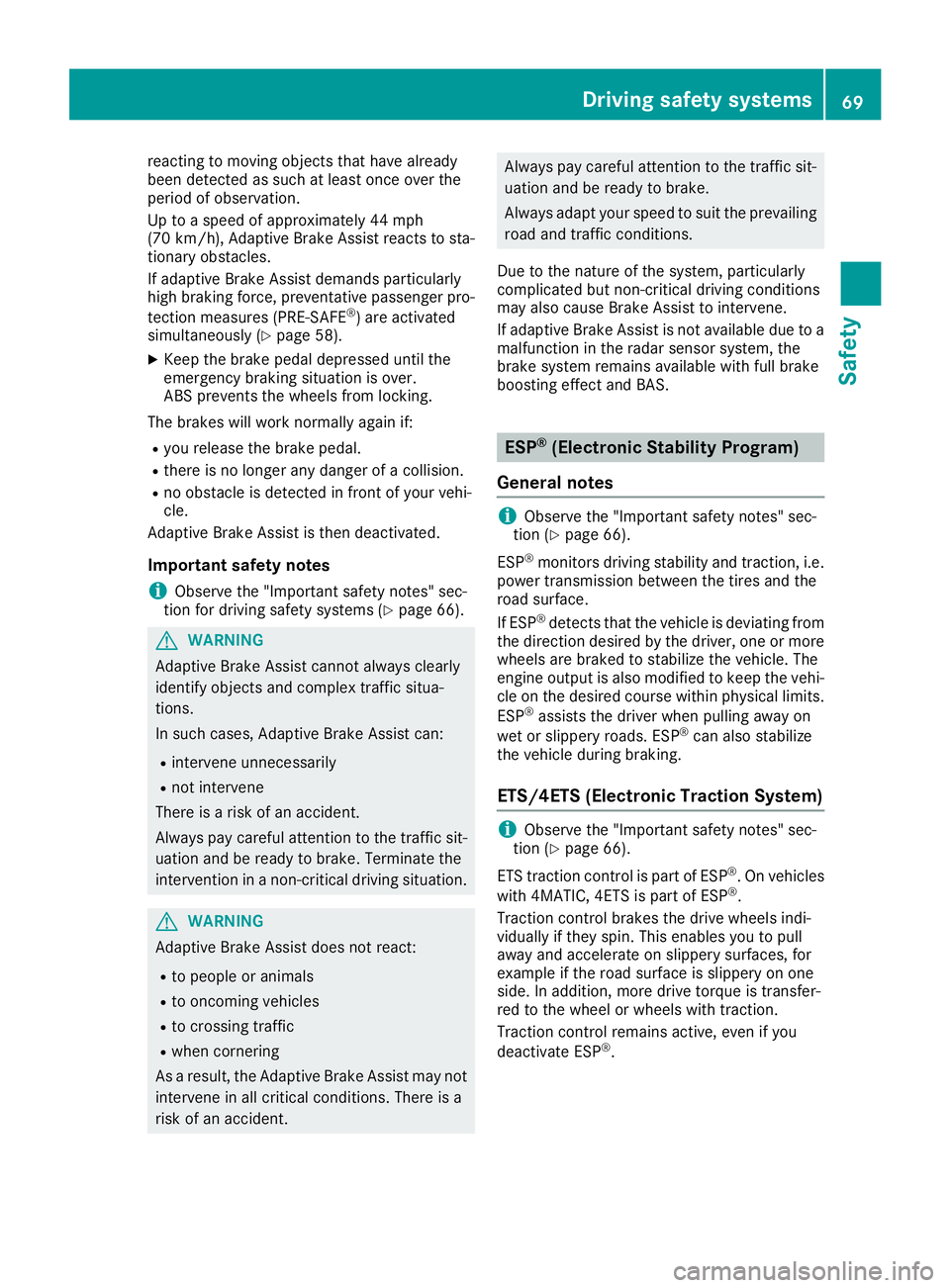
reacting to moving objects that have already
been detected as such at least once over the
period of observation.
Up to a speed of approximately 44 mph
(70 km/h), Adaptive Brake Assist reacts to sta-
tionary obstacles.
If adaptive Brake Assist demands particularly
high braking force, preventative passenger pro-
tection measures (PRE-SAFE ®
) are activated
simultaneously ( Y
page 58).X
Keep the brake pedal depressed until the
emergency braking situation is over.
ABS prevents the wheels from locking.
The brakes will work normally again if: R
you release the brake pedal. R
there is no longer any danger of a collision. R
no obstacle is detected in front of your vehi-
cle.
Adaptive Brake Assist is then deactivated.
Important safety notes
i Observe the "Important safety notes" sec-
tion for driving safety systems ( Y
page 66).
G WARNING
Adaptive Brake Assist cannot always clearly
identify objects and complex traffic situa-
tions.
In such cases, Adaptive Brake Assist can: R
intervene unnecessarily R
not intervene
There is a risk of an accident.
Always pay careful attention to the traffic sit-
uation and be ready to brake. Terminate the
intervention in a non-critical driving situation.
G WARNING
Adaptive Brake Assist does not react: R
to people or animals R
to oncoming vehicles R
to crossing traffic R
when cornering
As a result, the Adaptive Brake Assist may not
intervene in all critical conditions. There is a
risk of an accident. Always pay careful attention to the traffic sit-
uation and be ready to brake.
Always adapt your speed to suit the prevailing
road and traffic conditions.
Due to the nature of the system, particularly
complicated but non-critical driving conditions
may also cause Brake Assist to intervene.
If adaptive Brake Assist is not available due to a
malfunction in the radar sensor system, the
brake system remains available with full brake
boosting effect and BAS.
ESP ®
(Electronic Stability Program)
General notes
i Observe the "Important safety notes" sec-
tion ( Y
page 66).
ESP ®
monitors driving stability and traction, i.e.
power transmission between the tires and the
road surface.
If ESP ®
detects that the vehicle is deviating from
the direction desired by the driver, one or more
wheels are braked to stabilize the vehicle. The
engine output is also modified to keep the vehi-
cle on the desired course within physical limits.
ESP ®
assists the driver when pulling away on
wet or slippery roads. ESP ®
can also stabilize
the vehicle during braking.
ETS/4ETS (Electronic Traction System)
i Observe the "Important safety notes" sec-
tion ( Y
page 66).
ETS traction control is part of ESP ®
. On vehicles
with 4MATIC, 4ETS is part of ESP ®
.
Traction control brakes the drive wheels indi-
vidually if they spin. This enables you to pull
away and accelerate on slippery surfaces, for
example if the road surface is slippery on one
side. In addition, more drive torque is transfer-
red to the wheel or wheels with traction.
Traction control remains active, even if you
deactivate ESP ®
.Driving safety systems 69
Safety Z